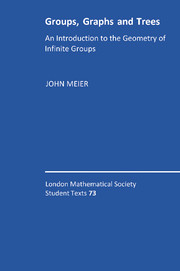Book contents
- Frontmatter
- Contents
- Preface
- 1 Cayley's Theorems
- 2 Groups Generated by Reflections
- 3 Groups Acting on Trees
- 4 Baumslag–Solitar Groups
- 5 Words and Dehn's Word Problem
- 6 A Finitely Generated, Infinite Torsion Group
- 7 Regular Languages and Normal Forms
- 8 The Lamplighter Group
- 9 The Geometry of Infinite Groups
- 10 Thompson's Group
- 11 The Large-Scale Geometry of Groups
- Bibliography
- Index
7 - Regular Languages and Normal Forms
Published online by Cambridge University Press: 05 June 2012
- Frontmatter
- Contents
- Preface
- 1 Cayley's Theorems
- 2 Groups Generated by Reflections
- 3 Groups Acting on Trees
- 4 Baumslag–Solitar Groups
- 5 Words and Dehn's Word Problem
- 6 A Finitely Generated, Infinite Torsion Group
- 7 Regular Languages and Normal Forms
- 8 The Lamplighter Group
- 9 The Geometry of Infinite Groups
- 10 Thompson's Group
- 11 The Large-Scale Geometry of Groups
- Bibliography
- Index
Summary
The concept of a finite-state automaton has emerged as significant in many branches of human knowledge and understanding, including linguistics, computer science, philosophy, biology and mathematics.… In our work, finite-state automata are of fundamental importance: our objective is to use them to understand individual groups.
–from Word Processing in Groups [E+92]Regular Languages and Automata
We have explored the word problem about as far as is prudent without being a bit more careful with words like “decide” and “construct.” Here we introduce a standard mathematical model of computation. In thinking about modelling computation, there are a few key aspects that need to be preserved. One needs to have a way of inputing a sequence of information, and then a machine needs to execute various commands based on the input. One expects the total number of computations to be finite and possibly that there is some provision for the machine to have memory. The notion of finite-state automata, and their corresponding languages, fits these expectations.
Definition 7.1. Given an alphabet S = {x1, …, xn}, any subset of words in the free monoid on S, ℒ ⊃ S*, is a language.
There are numerous examples of languages. If S = {a}, then the set of all strings of even length, {a2n | n ∈ ℕ}, forms a language.
- Type
- Chapter
- Information
- Groups, Graphs and TreesAn Introduction to the Geometry of Infinite Groups, pp. 130 - 150Publisher: Cambridge University PressPrint publication year: 2008



